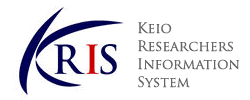-
Affiliation
-
Faculty of Science and Technology, Department of Electronics and Electrical Engineering ( Yagami )
-
Position
-
Professor
-
Related Websites

KEIO RESEARCHERS INFORMATION SYSTEM |
Details of a Researcher
このページはJavascriptを使用しています。すべての機能を使用するためにはJavascript を有効にする必要があります。
Ikehara, Masaaki
|
|
|
長崎大学工学部 ,専任講師
慶應義塾大学理工学部電気工学科 ,専任講師
慶應義塾大学理工学部電子工学科兼電気工学科 ,専任講師
慶應義塾大学理工学部 ,助教授
Keio University, Faculty of Engineering, 電気工学科
University, Graduated
Keio University, Graduate School, Division of Science and Engineeri, 電気工学専攻
Graduate School, Completed, Master's course
Keio University, Graduate School, Division of Science and Engineeri, 電気工学専攻
Graduate School, Completed, Doctoral course
Manufacturing Technology (Mechanical Engineering, Electrical and Electronic Engineering, Chemical Engineering) / Communication and network engineering (Digital Signal Processing)
MATLABマルティメディア信号処理(下)
IKEHARA MASAAKI, 培風館, 2005
培風館
IKEHARA MASAAKISHIMAMURA TETSUYA, 2004.01
培風館
池原 雅章、真田幸俊, 2002.02
科学技術出版
池原 雅章, 2001.09
培風館
高橋、池原, 培風館, 1999.07
Image Deraining with Frequency-Enhanced State Space Model
Yamashita S., Ikehara M.
Lecture Notes in Computer Science Including Subseries Lecture Notes in Artificial Intelligence and Lecture Notes in Bioinformatics 15475 LNCS 318 - 334 2025
ISSN 03029743
Efficient and Effective Blind JPEG Image Improvement With Sequential Feature Processing
Ezumi S., Ikehara M.
IEEE Access 12 151975 - 151986 2024.10
Research paper (scientific journal), Accepted
Edge-Guided Low-Light Image Enhancement Based on GAN with Effective Modules
Matsui T., Ikehara M.
European Signal Processing Conference 456 - 460 2024.09
Research paper (international conference proceedings), Accepted, ISSN 22195491
MSARNet: Efficient JPEG Artifact Removal Using Multi-Stage Style Network
Ezumi S., Ikehara M.
Digest of Technical Papers - IEEE International Conference on Consumer Electronics 2024.01
Research paper (international conference proceedings), Accepted, ISSN 0747668X
Faster Training of Large Kernel Convolutions on Smaller Spatial Scales
Fukuzaki S., Ikehara M.
IEEE Access 12 161312 - 161328 2024
Research paper (scientific journal)
Research on rapid and accurate image restoration by fusion of signal processing and deep learning
Ikehara, Masaaki
科学研究費補助金研究成果報告書 2022
High accuracy position and pose estimation for object recognition using phase information
Ikehara, Masaaki
科学研究費補助金研究成果報告書 2019
Design of 2D directional adaptive filter banks and its application to image coding
Ikehara, Masaaki
科学研究費補助金研究成果報告書 2011
Lifting Structure of M-channel Filter Banks and its Application to Lossy-Lossless Coding
IKEHARA, MASAAKI
科学研究費補助金研究成果報告書 2008
Image Rrestoration based on Weighted Average of Multiple Blurred and Noisy Images
Ryo Tanikawa, Takanori Fujisawa, Masaaki Ikehara
[International presentation] 2018 International Workshop on Advanced Image Technology (IWAIT 2018),
Oral presentation (general)
Noise Removal based on Surface Approximation of Color Line
Koichi Manabe Takuro Yamaguchi and Masaaki Ikehara
[International presentation] 2018 International Workshop on Advanced Image Technology (IWAIT 2018),
Oral presentation (general)
Random-valued Impulse Noise Removal Using Non-local Search for Similar Structures and Sparse Representation
Kengo Tsuda, Takanori Fujisawa, Masaaki Ikehara
[International presentation] 2018 International Workshop on Advanced Image Technology (IWAIT 2018),
Oral presentation (general)
Joint Bilateral based Image Denoising using Multi-sized 2D Hard Threshold
Yamaguchi Takuro and IKEHARA MASAAKI
[International presentation] Asia-Pacific Signal and Information Processing Association Annual Summit and Conference (APSIPA ASC) 2017 (Kuala Lumpur) ,
Oral presentation (general)
Color Image Coding based on Linear Combination of Adaptive Colorspaces
Takanori Fujisawa and Masaaki Ikehara
[International presentation] 42nd IEEE International Conference on Acoustics, Speech and Signal Processing(ICASSP 2017),
Oral presentation (general)
Degradation removal of images by nonlocal deep learning using signal processing techniques
基盤研究(C), Principal investigator
Research on rapid and accurate image restoration by fusion of signal processing and deep learning
MEXT,JSPS, Grant-in-Aid for Scientific Research, Grant-in-Aid for Scientific Research (C), Principal investigator
High accuracy position and pose estimation for object recognition using phase information
MEXT,JSPS, Grant-in-Aid for Scientific Research, Grant-in-Aid for Scientific Research (C), Principal investigator
フェロー
2015.09, 電子情報通信学会
Type of Award: Other
Senior Member
2001.06, IEEE
Type of Award: International academic award (Japan or overseas)
SIGNAL PROCESSING
2025
SEMINAR IN ELECTRONICS AND INFORMATION ENGINEERING(1)
2025
RECITATION IN ELECTRONICS AND INFORMATION ENGINEERING
2025
MEDIA SIGNAL PROCESSING
2025
LABORATORY IN SCIENCE
2025
IEEE Transaction on Signal Processing
電子情報通信学会信号処理研究専門委員会,
電子情報通信学会信号処理研究専門委員会,
IEEE,
電子情報通信学会 多次元信号処理特集号,
電子情報通信学会 信号処理特集号,
Committee Chair, 電子情報通信学会信号処理研究専門委員会
Committee Vice-Chair, 電子情報通信学会信号処理研究専門委員会
Senior Member, IEEE
Associate Editor, IEEE Transaction on Signal Processing
編集委員, 電子情報通信学会 多次元信号処理特集号